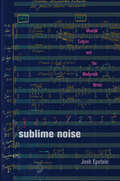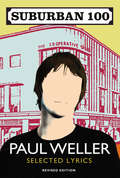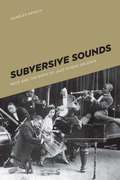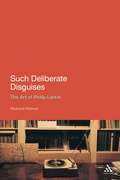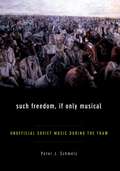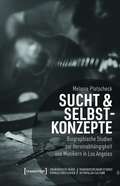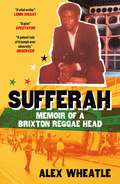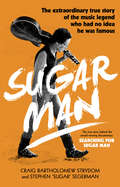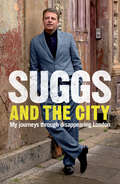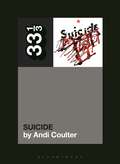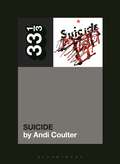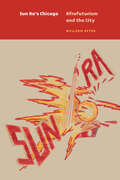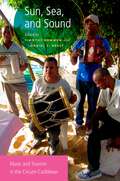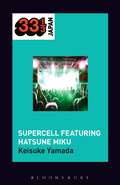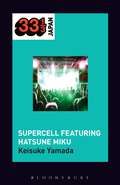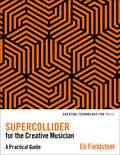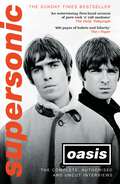- Table View
- List View
Sublime Noise: Musical Culture and the Modernist Writer (Hopkins Studies in Modernism)
by Josh EpsteinWhen Stravinsky’s Rite of Spring premiered in Paris in 1913, the crowd rioted in response to the harsh dissonance and jarring rhythms of its score. This was noise, not music. In Sublime Noise, Josh Epstein examines the significance of noise in modernist music and literature. Howâ€�and whyâ€�did composers and writers incorporate the noises of modern industry, warfare, and big-city life into their work?Epstein argues that, as the creative class engaged with the racket of cityscapes and new media, they reconsidered not just the aesthetic of music but also its cultural effects. Noise, after all, is more than a sonic category: it is a cultural value judgmentâ€�a way of abating and categorizing the sounds of a social space or of new music. Pulled into dialogue with modern music’s innovative rhythms, noise signaled the breakdown of art’s autonomy from social lifeâ€�even the "old favorites" of Beethoven and Wagner took on new cultural meanings when circulated in noisy modern contexts. The use of noise also opened up the closed space of art to the pressures of publicity and technological mediation.Building both on literary cultural studies and work in the "new musicology," Sublime Noise examines the rich material relationship that exists between music and literature. Through close readings of modernist authors, including James Joyce, T. S. Eliot, Edith Sitwell, E. M. Forster, and Ezra Pound, and composers, including George Antheil, William Walton, Erik Satie, and Benjamin Britten, Epstein offers a radically contemporary account of musical-literary interactions that goes well beyond pure formalism. This book will be of interest to scholars of Anglophone literary modernism and to musicologists interested in how music was given new literary and cultural meaning during that complex interdisciplinary period.
Suburban 100: Selected Lyrics
by Paul WellerREVISED, UPDATED AND WITH A NEW FOREWORD BY PAUL ABBOTTThis edition of Suburban 100 includes new lyrics from the critically acclaimed albums, 22 Dreams and Wake Up the Nation, which has been nominated for the Mercury Music Award.Paul Weller first burst onto the national music scene with The Jam in 1977 and was quickly marked apart from his contemporaries as a brilliant lyricist. In a writing career that has now spanned three decades, his songs have been acclaimed, imitated and loved by many. Suburban 100 - the first selection of Paul Weller's lyrics - draws on songs written for The Jam, The Style Council and solo releases that, together, tell stories of life and love, rage and romance. The youthful frustrations of small-town life that fuelled Weller's early writing is palpable, as is the angry but poignant response to Thatcher's Britain. His lyrics, rooted in English suburban culture, explore the hopes, dreams and crashing disappointments of ordinary people. They also revel in the mystical beauty of the English country landscape and repeatedly revisit dreamlike childhood summers.For the first time Paul Weller shares his reflections on his lyrics, offering candid insights to his writing process and the inspiration behind some of pop music's best loved songs. Suburban 100 reveals aspects of a famously private man.
Subversive Sounds: Race and the Birth of Jazz in New Orleans (Studies In Communication, Media, And Public Opinion Ser.)
by Charles B. HerschSubversive Sounds probes New Orleans’s history, uncovering a web of racial interconnections and animosities that was instrumental to the creation of a vital American art form—jazz. Drawing on oral histories, police reports, newspaper accounts, and vintage recordings, Charles Hersch brings to vivid life the neighborhoods and nightspots where jazz was born. This volume shows how musicians such as Jelly Roll Morton, Nick La Rocca, and Louis Armstrong negotiated New Orleans’s complex racial rules to pursue their craft and how, in order to widen their audiences, they became fluent in a variety of musical traditions from diverse ethnic sources. These encounters with other music and races subverted their own racial identities and changed the way they played—a musical miscegenation that, in the shadow of Jim Crow, undermined the pursuit of racial purity and indelibly transformed American culture. “More than timely . . . Hersch orchestrates voices of musicians on both sides of the racial divide in underscoring how porous the music made the boundaries of race and class.”—New Orleans Times-Picayune
Subversive Sounds: Race and the Birth of Jazz in New Orleans
by Charles B. HerschSubversive Sounds probes New Orleans’s history, uncovering a web of racial interconnections and animosities that was instrumental to the creation of a vital American art form—jazz. Drawing on oral histories, police reports, newspaper accounts, and vintage recordings, Charles Hersch brings to vivid life the neighborhoods and nightspots where jazz was born. This volume shows how musicians such as Jelly Roll Morton, Nick La Rocca, and Louis Armstrong negotiated New Orleans’s complex racial rules to pursue their craft and how, in order to widen their audiences, they became fluent in a variety of musical traditions from diverse ethnic sources. These encounters with other music and races subverted their own racial identities and changed the way they played—a musical miscegenation that, in the shadow of Jim Crow, undermined the pursuit of racial purity and indelibly transformed American culture. “More than timely . . . Hersch orchestrates voices of musicians on both sides of the racial divide in underscoring how porous the music made the boundaries of race and class.”—New Orleans Times-Picayune
Subversive Sounds: Race and the Birth of Jazz in New Orleans (Studies In Communication, Media, And Public Opinion)
by Charles B. HerschSubversive Sounds probes New Orleans’s history, uncovering a web of racial interconnections and animosities that was instrumental to the creation of a vital American art form—jazz. Drawing on oral histories, police reports, newspaper accounts, and vintage recordings, Charles Hersch brings to vivid life the neighborhoods and nightspots where jazz was born. This volume shows how musicians such as Jelly Roll Morton, Nick La Rocca, and Louis Armstrong negotiated New Orleans’s complex racial rules to pursue their craft and how, in order to widen their audiences, they became fluent in a variety of musical traditions from diverse ethnic sources. These encounters with other music and races subverted their own racial identities and changed the way they played—a musical miscegenation that, in the shadow of Jim Crow, undermined the pursuit of racial purity and indelibly transformed American culture. “More than timely . . . Hersch orchestrates voices of musicians on both sides of the racial divide in underscoring how porous the music made the boundaries of race and class.”—New Orleans Times-Picayune
Such Deliberate Disguises: The Art Of Philip Larkin
by Richard PalmerSuch Deliberate Disguises: The Art of Philip Larkin argues that a true understanding of Philip Larkin as man and poet lies beyond his enduring public appeal and the variety of criticism that has recently been applied to his work. Richard Palmer suggests that the ostensible simplicity of Larkin's writing, which continues to attract so many readers to him, is deceptive, masking as it does one of the richest and most resonant of oeuvres in twentieth-century poetry. Penetrating the many masks of Larkin, the book sheds new and considerable light on the hitherto largely ignored spiritual significance of his work. Based upon close and scrupulous reading of the poems themselves, it draws upon insights gained from the history of art and the study of religion and myth as much as literary criticism and personal biography. It also brings long-overdue attention to what is seen to be perhaps the chief love, and operative aesthetic force, of Larkin's life: jazz. Such Deliberate Disguises is thus a major contribution, not just to Larkin studies, but to the wider cultural history of our times.
Such Freedom, If Only Musical: Unofficial Soviet Music During the Thaw
by Peter J SchmelzFollowing Stalin's death in 1953, during the period now known as the Thaw, Nikita Khrushchev opened up greater freedoms in cultural and intellectual life. A broad group of intellectuals and artists in Soviet Russia were able to take advantage of this, and in no realm of the arts was this perhaps more true than in music. Students at Soviet conservatories were at last able to use various channels--many of questionable legality--to acquire and hear music that had previously been forbidden, and visiting performers and composers brought young Soviets new sounds and new compositions. In the 1960s, composers such as Andrey Volkonsky, Edison Denisov, Alfred Schnittke, Arvo Pärt, Sofia Gubaidulina, and Valentin Silvestrov experimented with a wide variety of then new and unfamiliar techniques ranging from serialism to aleatory devices, and audiences eager to escape the music of predictable sameness typical to socialist realism were attracted to performances of their new and unfamiliar creations. This "unofficial" music by young Soviet composers inhabited the gray space between legal and illegal. Such Freedom, If Only Musical traces the changing compositional styles and politically charged reception of this music, and brings to life the paradoxical freedoms and sense of resistance or opposition that it suggested to Soviet listeners. Author Peter J. Schmelz draws upon interviews conducted with many of the most important composers and performers of the musical Thaw, and supplements this first-hand testimony with careful archival research and detailed musical analyses. The first book to explore this period in detail, Such Freedom, If Only Musical will appeal to musicologists and theorists interested in post-war arts movements, the Cold War, and Soviet music, as well as historians of Russian culture and society.
Such Freedom, If Only Musical: Unofficial Soviet Music During the Thaw
by Peter J SchmelzFollowing Stalin's death in 1953, during the period now known as the Thaw, Nikita Khrushchev opened up greater freedoms in cultural and intellectual life. A broad group of intellectuals and artists in Soviet Russia were able to take advantage of this, and in no realm of the arts was this perhaps more true than in music. Students at Soviet conservatories were at last able to use various channels--many of questionable legality--to acquire and hear music that had previously been forbidden, and visiting performers and composers brought young Soviets new sounds and new compositions. In the 1960s, composers such as Andrey Volkonsky, Edison Denisov, Alfred Schnittke, Arvo P?rt, Sofia Gubaidulina, and Valentin Silvestrov experimented with a wide variety of then new and unfamiliar techniques ranging from serialism to aleatory devices, and audiences eager to escape the music of predictable sameness typical to socialist realism were attracted to performances of their new and unfamiliar creations. This "unofficial" music by young Soviet composers inhabited the gray space between legal and illegal. Such Freedom, If Only Musical traces the changing compositional styles and politically charged reception of this music, and brings to life the paradoxical freedoms and sense of resistance or opposition that it suggested to Soviet listeners. Author Peter J. Schmelz draws upon interviews conducted with many of the most important composers and performers of the musical Thaw, and supplements this first-hand testimony with careful archival research and detailed musical analyses. The first book to explore this period in detail, Such Freedom, If Only Musical will appeal to musicologists and theorists interested in post-war arts movements, the Cold War, and Soviet music, as well as historians of Russian culture and society.
Sucht & Selbstkonzepte: Biographische Studien zur Heroinabhängigkeit von Musikern in Los Angeles (Transdisziplinäre Popkulturstudien #3)
by Melanie PtatscheckGetreu dem Motto »Sex & Drugs & Rock'n'Roll« scheint der Konsum von Drogen geradezu prototypisch zum Lifestyle vieler Musiker*innen dazuzugehören. Auffällig ist, dass es immer wieder musikalische Vertreter*innen des Typus »Junkie« sind, die zu Weltstars und Ikonen werden. Doch warum ist dieser Lebenswandel und dabei ausgerechnet der Konsum von Heroin so populär (gewesen)? Durch die Rekonstruktion individueller Lebensgeschichten heroinabhängiger Musiker in Los Angeles bestimmt Melanie Ptatscheck nicht nur sozialpsychologische und musikspezifische Suchtfaktoren. Ebenso zeigt sie auf, durch welche individuellen Bedürfnisse und gesellschaftlichen Narrative die Selbstvorstellungen dieser Musiker geprägt sind.
Sufferah: Memoir of a Brixton Reggae Head
by Alex Wheatle"One of the big memoirs of the summer" i news"Alex is a truly gifted storyteller, and the way he details his own story here is no exception" JEFFREY BOAKYE In this breathtaking memoir, acclaimed writer Alex Wheatle shows how music became his salvation through a childhood marred by abuse.Abandoned as a baby to the British care system, Alex grows up with no knowledge of his Jamaican parentage or family history. Later, he is inexorably drawn to reggae, his lifeline through disrupted teenage years, the challenges of living as a young Black man in 1980s Britain and his imprisonment for protesting against systemic racism and police brutality.Alex's youth was portrayed in Oscar Award-winning director Steve McQueen's Small Axe series. In Sufferah, he tells his own story, urgently, vividly and unsentimentally. His award-winning fiction - and this memoir - are a call to never give up hope. They remind us that words can be our sustenance, and music our heartbeat. "Alex Wheatle is the real deal; he writes with heart and authenticity, books that make you laugh and worry and cry and hold your breath" KIT DE WAAL"Alex Wheatle is an inspirer. He sheds light in dark places . . . He is a vital writer" LEMN SISSAY"Alex Wheatle writes from a place of honesty and passion" STEVE McQUEEN, director of Small Axe
Sugar Man: The Life, Death and Resurrection of Sixto Rodriguez
by Craig Bartholomew Strydom Stephen 'Sugar' SegermanIn the summer of 1972, during a compulsory stint in the South African military, Stephen 'Sugar' Segerman heard the music that would forever change his life. A decade later, on yet another military base, Craig Bartholomew Strydom heard the same music. It would have a profound effect. Who was this folk singer who resonated with South Africa's youth? No one could say. All that anyone knew was his name - Rodriguez - and the fact that he had killed himself on stage after reading his own epitaph.After many years of searching in a pre-internet age, Strydom with support from Segerman found the musician not dead but alive and living in seclusion in Detroit. Even more remarkable was the fact that Rodriguez, no longer working as a musician and struggling to eke out a blue-collar existence, had no idea that he had been famous for over 25 years in a remote part of the world...
Suggs and the City: Journeys through Disappearing London
by SuggsRevelling in the off-beat and eccentric, Londoner Suggs takes us on a nostalgic adventure to explore the disappearing history of his extraordinary home town: from the sharp tailors of Saville Row to the sex traders of Bohemian Soho, by way of quaint and quirky habitats, brilliant but endangered boozers, unique eateries that have introduced the capital to the world's finest foods and a music scene that's dear to his heart.
Suicide's Suicide (33 1/3)
by Andi CoulterNew York City in the 1970s was an urban nightmare: destitute, dirty, and dangerous. As the country collectively turned its back on the Big Apple, two musical vigilantes rose out of the miasma. Armed only with amplified AC current, Suicide's Alan Vega and Marty Rev set out to save America's soul. Their weaponized noise terrorized unsuspecting audiences. Suicide could start a riot on a lack of guitar alone. Those who braved their live shows often fled in fear--or formed bands (sometimes both). This book attempts to give the reader a front-row seat to a Suicide show. Suicide is one of the most original, most misunderstood, and most influential bands of the last century. While Suicide has always had a dedicated cult following, the band is still relatively unknown outside their musical coterie. Arguing against the idea of the band's niche musical history, this book looks at parallels between Marvel Comics' antiheroes in the 1970s and Suicide's groundbreaking first album. Andi Coulter tells the origin story of two musical Ghost Riders learning to harness their sonic superpower, using noise like a clarion call for a better future.
Suicide's Suicide (33 1/3 #149)
by Andi CoulterNew York City in the 1970s was an urban nightmare: destitute, dirty, and dangerous. As the country collectively turned its back on the Big Apple, two musical vigilantes rose out of the miasma. Armed only with amplified AC current, Suicide's Alan Vega and Marty Rev set out to save America's soul. Their weaponized noise terrorized unsuspecting audiences. Suicide could start a riot on a lack of guitar alone. Those who braved their live shows often fled in fear--or formed bands (sometimes both). This book attempts to give the reader a front-row seat to a Suicide show. Suicide is one of the most original, most misunderstood, and most influential bands of the last century. While Suicide has always had a dedicated cult following, the band is still relatively unknown outside their musical coterie. Arguing against the idea of the band's niche musical history, this book looks at parallels between Marvel Comics' antiheroes in the 1970s and Suicide's groundbreaking first album. Andi Coulter tells the origin story of two musical Ghost Riders learning to harness their sonic superpower, using noise like a clarion call for a better future.
Sun Ra's Chicago: Afrofuturism and the City (Historical Studies of Urban America)
by William SitesSun Ra (1914–93) was one of the most wildly prolific and unfailingly eccentric figures in the history of music. Renowned for extravagant performances in which his Arkestra appeared in neo-Egyptian garb, the keyboardist and bandleader also espoused an interstellar cosmology that claimed the planet Saturn as his true home. In Sun Ra’s Chicago, William Sites brings this visionary musician back to earth—specifically to the city’s South Side, where from 1946 to 1961 he lived and relaunched his career. The postwar South Side was a hotbed of unorthodox religious and cultural activism: Afrocentric philosophies flourished, storefront prophets sold “dream-book bibles,” and Elijah Muhammad was building the Nation of Islam. It was also an unruly musical crossroads where the man then known as Sonny Blount drew from an array of intellectual and musical sources—from radical nationalism, revisionist Christianity, and science fiction to jazz, blues, Latin dance music, and pop exotica—to construct a philosophy and performance style that imagined a new identity and future for African Americans. Sun Ra’s Chicago shows that late twentieth-century Afrofuturism emerged from a deep, utopian engagement with the city—and that by excavating the postwar black experience of Sun Ra’s South Side milieu, we can come to see the possibilities of urban life in new ways.
Sun, Sea, and Sound: Music and Tourism in the Circum-Caribbean
by Timothy Rommen Daniel T. NeelyMusic and tourism, both integral to the culture and livelihood of the circum-Caribbean region, have until recently been approached from disparate disciplinary perspectives. Scholars who specialize in tourism studies typically focus on issues such as economic policy, sustainability, and political implications; music scholars are more likely to concentrate on questions of identity, authenticity, neo-colonialism, and appropriation. Although the insights generated by these paths of scholarship have long been essential to study of the region, Sun, Sea, and Sound turns its attention to the dynamics and interrelationships between tourism and music throughout the region. Editors Timothy Rommen and Daniel T. Neely bring together a group of leading scholars from the fields of ethnomusicology, anthropology, mobility studies, and history to develop and explore a framework - termed music touristics - that considers music in relation to the wide range of tourist experiences that have developed in the region. Over the course of eleven chapters, the authors delve into an array of issues including the ways in which countries such as Jamaica and Cuba have used music to distinguish themselves within the international tourism industry, the tourism surrounding music festivals in Guadeloupe and New Orleans, the intersections between music and sex tourism in Brazil, and spirituality tourism in Cuba. An indispensable resource for the study of music and tourism in global perspective, Sun, Sea, and Sound is essential reading for scholars and students across disciplines interested in the Caribbean region.
Supercell's Supercell featuring Hatsune Miku (33 1/3 Japan)
by Keisuke YamadaThe lead singer on Supercell's eponymous first album is Hatsune Miku-a Vocaloid character created by Crypton Future Media with voice synthesizers. A virtual superstar, over 100,000 songs, uploaded mostly by fans, are attributed to her. Supercell is a Japanese creator music group with the composer Ryo leading ten artists, who design album illustrations and make music videos. These videos are uploaded onto Niconico and other video-sharing sites. By the time Supercell was released in March 2009, the group's Vocaloid works were already well-known to Niconico users and fans. This book explores the Vocaloid and DTM (desktop music) phenomena through the lenses of media and fan studies, looking closely at online social media platforms, the new technology for composing, avid fans of the Vocaloid character, and these fans' performative practices. It provides a sense of how interactive new media and an empowered fan base combine to engage in the creation processes and enhance the circulation of DTM works.33 1/3 Global, a series related to but independent from 33 1/3, takes the format of the original series of short, music-basedbooks and brings the focus to music throughout the world. With initial volumes focusing on Japanese and Brazilian music, the series will also include volumes on the popular music of Australia/Oceania, Europe, Africa, the Middle East, and more.
Supercell's Supercell featuring Hatsune Miku (33 1/3 Japan)
by Keisuke YamadaThe lead singer on Supercell's eponymous first album is Hatsune Miku-a Vocaloid character created by Crypton Future Media with voice synthesizers. A virtual superstar, over 100,000 songs, uploaded mostly by fans, are attributed to her. Supercell is a Japanese creator music group with the composer Ryo leading ten artists, who design album illustrations and make music videos. These videos are uploaded onto Niconico and other video-sharing sites. By the time Supercell was released in March 2009, the group's Vocaloid works were already well-known to Niconico users and fans. This book explores the Vocaloid and DTM (desktop music) phenomena through the lenses of media and fan studies, looking closely at online social media platforms, the new technology for composing, avid fans of the Vocaloid character, and these fans' performative practices. It provides a sense of how interactive new media and an empowered fan base combine to engage in the creation processes and enhance the circulation of DTM works.33 1/3 Global, a series related to but independent from 33 1/3, takes the format of the original series of short, music-basedbooks and brings the focus to music throughout the world. With initial volumes focusing on Japanese and Brazilian music, the series will also include volumes on the popular music of Australia/Oceania, Europe, Africa, the Middle East, and more.
SuperCollider for the Creative Musician: A Practical Guide (Creating Technology for Music)
by Eli FieldsteelSuperCollider, an open-source, cross-platform software program for real-time sound synthesis and algorithmic composition, was created by James McCartney in 1996 and has evolved to become a powerful tool for music composition and research. Written by composer and sound artist Eli Fieldsteel, who has almost two decades' experience of using SuperCollider for a variety of creative audio projects, SuperCollider for the Creative Musician is a comprehensive tutorial and reference guide for students, composers, and practitioners seeking a structured educational tour through this unique and flexible software. The book begins with platform-specific fundamentals, explores a large family of creative techniques, and then guides the reader through the nuances of assembling, navigating, and performing large-scale projects. Key topics include synthesis, sampling, sequencing, signal processing, external control, and graphical user interface design. Written with both beginners and intermediate practitioners in mind, this book is an invaluable resource for sound creators whose background falls anywhere on the spectrum between musician and computer programmer, and who seek to add new and innovative code-based techniques to their skill set. The companion website has an extensive collection of detailed code examples, which can be downloaded for exploration, experimentation, and hands-on learning.
SuperCollider for the Creative Musician: A Practical Guide (Creating Technology for Music)
by Eli FieldsteelSuperCollider, an open-source, cross-platform software program for real-time sound synthesis and algorithmic composition, was created by James McCartney in 1996 and has evolved to become a powerful tool for music composition and research. Written by composer and sound artist Eli Fieldsteel, who has almost two decades' experience of using SuperCollider for a variety of creative audio projects, SuperCollider for the Creative Musician is a comprehensive tutorial and reference guide for students, composers, and practitioners seeking a structured educational tour through this unique and flexible software. The book begins with platform-specific fundamentals, explores a large family of creative techniques, and then guides the reader through the nuances of assembling, navigating, and performing large-scale projects. Key topics include synthesis, sampling, sequencing, signal processing, external control, and graphical user interface design. Written with both beginners and intermediate practitioners in mind, this book is an invaluable resource for sound creators whose background falls anywhere on the spectrum between musician and computer programmer, and who seek to add new and innovative code-based techniques to their skill set. The companion website has an extensive collection of detailed code examples, which can be downloaded for exploration, experimentation, and hands-on learning.
Supersonic: The Complete, Authorised and Uncut Interviews
by Oasis'We are the biggest band in Britain of all time, ever. The funny thing is, all that fucking mouthing off three years ago about how we were going to be the biggest band in the world - we actually went and did it.' Noel GallagherOasis are one of the biggest bands the world has ever seen. Here, in Supersonic, they tell the story of their beginnings from dive-bar hopefuls to global superstars. They themselves talk us through the pivotal moments in their phenomenal trajectory, from the day Noel Gallagher joined his brother Liam's band, through their first crucial five years culminating at their landmark gigs at Knebworth Park in 1996 - the pinnacle of their success.With over thirty hours of interviews with Liam, Noel and those closest to them, this book documents in unprecedented depth and with their trademark candour and humour, the story behind one of the world's greatest bands, all told in their own words and fully illustrated with exclusive photographs and ephemera throughout.
Superstar Guitars: Explore the guitars that changed music forever
by Eleanor JaneForeword by James Dean Bradfield, Manic Street PreachersA collection that has to be seen to be believed, Superstar Guitars showcases the most famous six-strings in the history of music, in exquisite detail.Photographer Eleanor Jane has travelled the world, documenting the legendary guitars used to create some of the greatest music ever heard.Jimi Hendrix's Woodstock Stratocaster. The guitar on which Bob Dylan 'went electric'. The Fender Mustang Kurt Cobain played in the 'Smells Like Teen Spirit' video. Explore some of the most iconic guitars in music, up close and personal.Detailed photography explores every inch of these iconic instruments, telling the stories of the guitars that changed the world.Guitars featured include:Jimi Hendrix's Woodstock StratocasterKurt Cobain's 'Smells Like Teen Spirit' MustangJohn Frusciante's Fender StratocasterDave Grohl's Gibson Trini LopezNoel Gallagher's Epiphone Riviera Eric Clapton's MTV Unplugged Martin Jeff Buckley's Fender TelecasterBrian May's Red SpecialTom Morello's Arm The HomelessPhoebe Bridgers' Danelectro BaritoneJack White's Airline Prince's Yellow CloudThurston Moore's Fender JazzmasterDavid Gilmour's Black StratSteve Vai's Ibanez JEMMatt Bellamy's Mansion DeLoreanAnd many more...
Supporting Vulnerable Performance Traditions: Keeping it Going in Contexts of Continuity and Change
by Georgia Curran Mahesh White-RadhakrishnanSupporting Vulnerable Performance Traditions: Keeping it Going in Contexts of Continuity and Change explores endangered forms of performance from across the world, and the aspirations of practitioners, community members and researchers to keep these traditions going.Readers are provided with an ethnographically rich focus on specific performance contexts in diverse cultural worlds, including case studies that cover: Irish traditional song, ritual performances from southern India, Aboriginal ceremonial songs from northern and central Australia, Latin Catholic rites in multicultural Australia, and Asian-Portuguese syncretic dance in Sri Lanka. With contributors who are all scholars and/or practitioners of music, dance and other temporal arts, this book offers an inside view on the importance of these traditions for peoples' expressions of their distinct cultural identities and assertions of their uniqueness.Supporting Vulnerable Performance Traditions contains essential insights into musical cultures in the context of continuity and change, and will be of interest to researchers and postgraduates of ethnomusicology, anthropology, performance studies and Asian studies, as well as music historians and practitioners, and musicians and culture bearers across the world.
Supporting Vulnerable Performance Traditions: Keeping it Going in Contexts of Continuity and Change
Supporting Vulnerable Performance Traditions: Keeping it Going in Contexts of Continuity and Change explores endangered forms of performance from across the world, and the aspirations of practitioners, community members and researchers to keep these traditions going.Readers are provided with an ethnographically rich focus on specific performance contexts in diverse cultural worlds, including case studies that cover: Irish traditional song, ritual performances from southern India, Aboriginal ceremonial songs from northern and central Australia, Latin Catholic rites in multicultural Australia, and Asian-Portuguese syncretic dance in Sri Lanka. With contributors who are all scholars and/or practitioners of music, dance and other temporal arts, this book offers an inside view on the importance of these traditions for peoples' expressions of their distinct cultural identities and assertions of their uniqueness.Supporting Vulnerable Performance Traditions contains essential insights into musical cultures in the context of continuity and change, and will be of interest to researchers and postgraduates of ethnomusicology, anthropology, performance studies and Asian studies, as well as music historians and practitioners, and musicians and culture bearers across the world.
